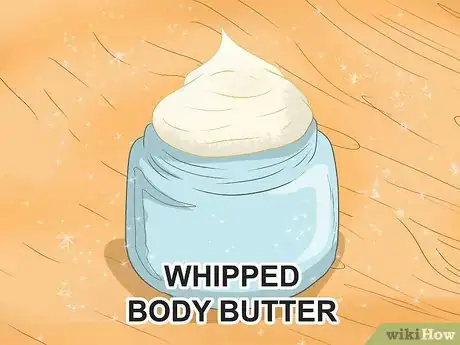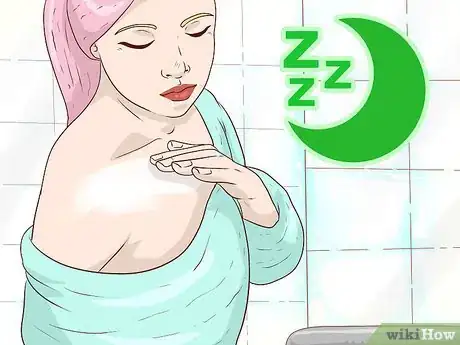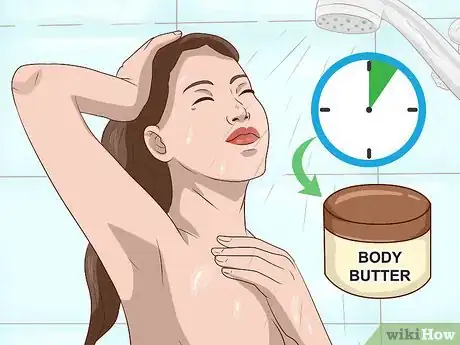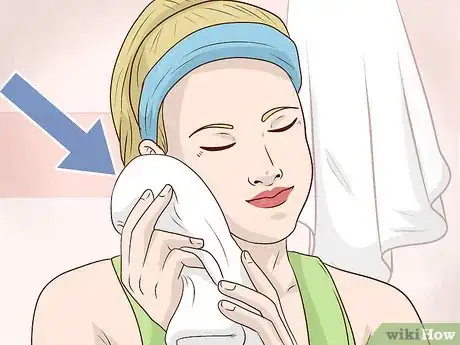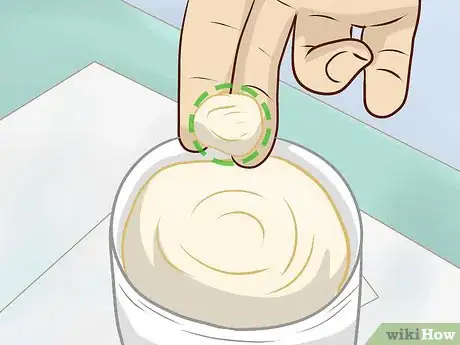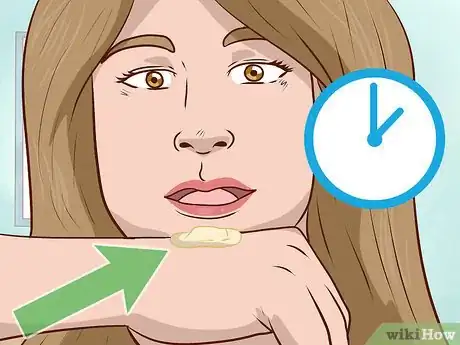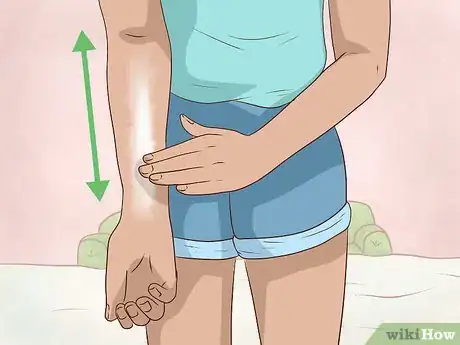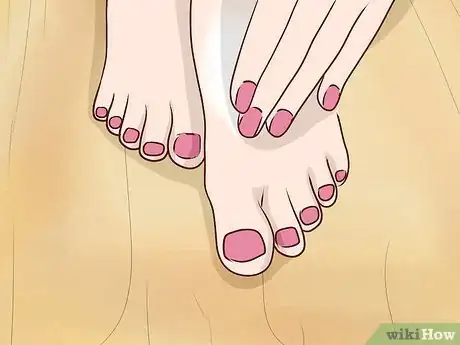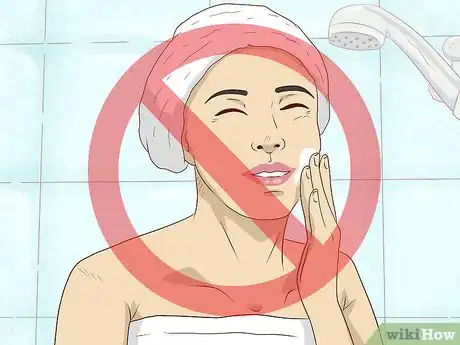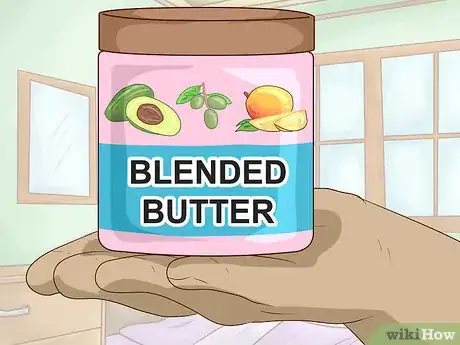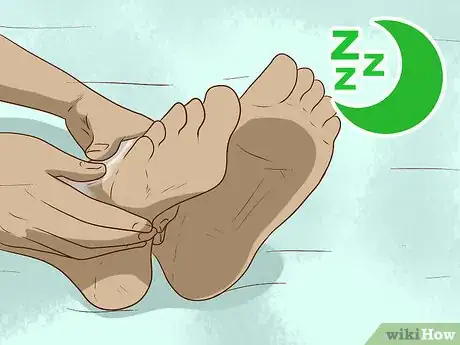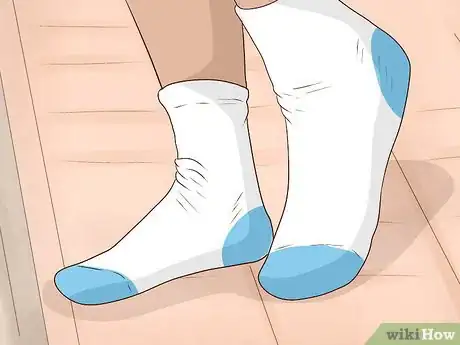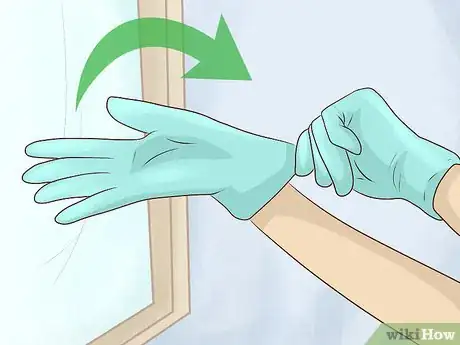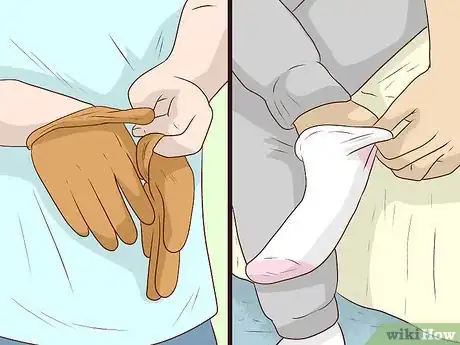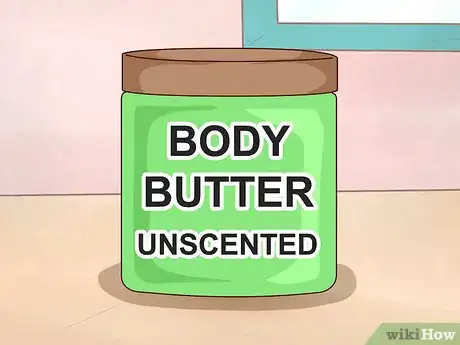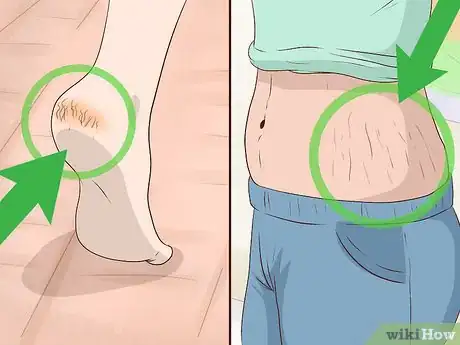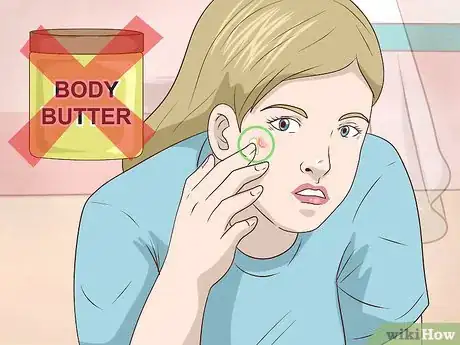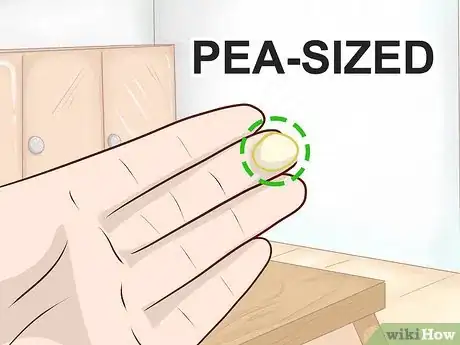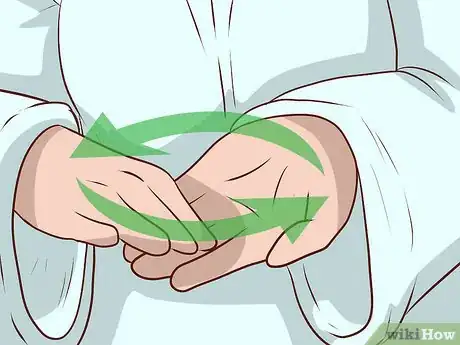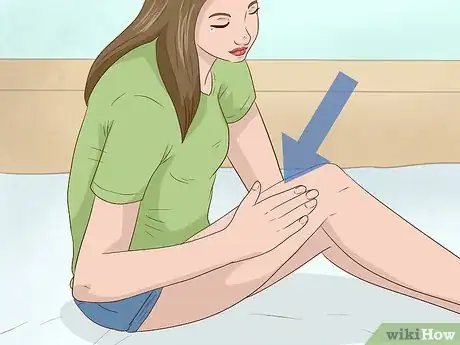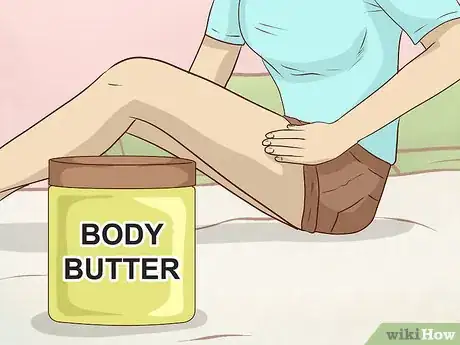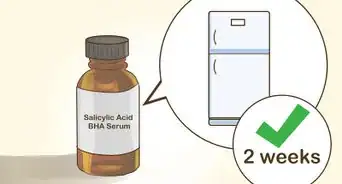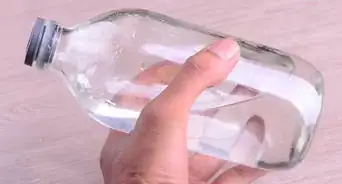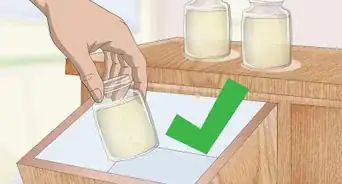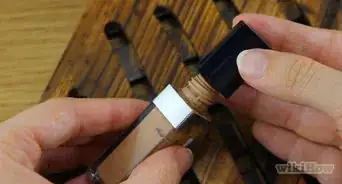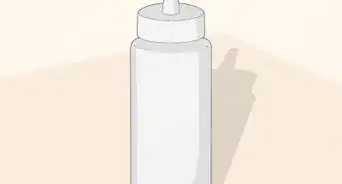This article was co-authored by Aparna Ghosh and by wikiHow staff writer, Danielle Blinka, MA, MPA. Aparna Ghosh is a Licensed Esthetician & Electrologist and the Owner of Synergy Skincare in Folsom, California. She has been running Synergy Skincare since 2017 and has over eight years of industry experience working with various skin types. Aparna specializes in corrective and preventative skincare. She is a Kaiser Permanente Network Provider providing electrolysis hair removal for transgender patients diagnosed with adult gender dysphoria and gender incongruence. In addition to being certified in skin health and herbology, she holds a Master's degree in Zoology with a specialization in Biochemistry and a Bachelor’s degree in Zoology with a minor in Chemistry. Synergy Skincare won the Hall of Fame Best in Folsom Award in 2019 and 2022 and the Yelp Recognition Badge in 2017 and 2020.
This article has been viewed 81,136 times.
Body butters are made from natural butters, usually created from extracts taken from nuts and seeds. Like lotion, they can keep your skin soft and moisturized. They’re formulated without water, so they often have thicker textures that becomes solid at room temperature.[1] Although body butters might seem difficult to use at first, they’re easy to apply as a moisturizer after a shower or before bed to make your skin feel silky smooth. You can also use them for an intense hand and feet treatment or to treat certain skin conditions.
Steps
Using Body Butter as a Moisturizer
-
1Choose a spreadable body butter for easy use. These body butters are often labeled as "whipped." You can also look for blends that contain oils or butters that are liquid at room temperature, such as coconut oil, jojoba oil, almond oil, or grapeseed oil. This makes the body butter easy to scoop out and apply to your body.[2]
- If you choose a body butter that is thicker or solid at room temperature, you can still use it as a moisturizer. Scoop out the amount you want to use, then give it a moment to melt in your palm.
-
2Apply it to your body before bed for an intense moisture treatment. When you sleep with the body butter on your skin, it has more time to soak in. Additionally, the heat from the blankets will warm you up, providing a more intensive treatment.[3]
- If you have dry skin, you can do this every day, if you'd like. If your skin is normal or oily, then you might do an intensive moisture treatment once a week or as needed.
- Keep in mind that some of the body butter might rub off on your blankets. In rare cases, it can cause oil stains on the fabric. However, your washing machine should remove the body butter, if you do get it on the blankets.
Advertisement -
3Seal in moisture by using it within 5 minutes of showering. You can use the body butter after your shower at any time of day, but taking a shower right before bed will have the best benefits. Applying the lotion right after a shower will seal in the moisture that remains on your skin.[4]
- A warm shower is your best option for moist skin, as it warms up the body. However, hot water can dry out your skin.
- You can use your body butter daily or as needed. For dry skin, it's a good idea to use it daily. If you have normal or oily skin, you might use it as a weekly treatment or to treat dry areas.
-
4Dab wet skin dry with a towel, leaving a little moisture. You want to remove most of the water, but your skin should look dewy. While body butter can seal in a light layer of moisture, it will be hard to smooth it on if you have too much water on your skin, as the butter will interact with the water.[5]
-
5Scoop out about a dime-sized amount of body butter. You can use your fingers or a spatula. It’s best to apply the body butter in small amounts. It may take longer to apply than a typical lotion, but taking your time will prevent your skin from feeling greasy.
- If you used a spatula, you can apply the body butter directly to your skin or onto your fingertips. You may prefer to use a spatula so that the body butter doesn’t get under your nails and to avoid contaminating the container with bacteria that may be on your hands.
- If your body butter is in a squeeze container, apply the butter directly from the container onto your skin.[6]
-
6Wait a few seconds for the warmth in your skin to melt the body butter. If you used your fingers, then you can rub the body butter between your fingertips. If you applied it directly to your body, then let it sit for a few seconds before you start to rub it in.[7]
- The natural warmth from your body will soften the body butter so that it smooths on easily.
-
7Rub in the body butter using long, firm strokes. Use the palm of your hands for the easiest application. You can also work it in over the joint areas, such as your knees, ankles, and elbows, using firm, circular strokes.[8]
- Stop rubbing the body butter once you've smoothed it into a thin, even layer. Your skin may look slightly greasy.
-
8Work in small sections, applying more body butter as necessary. However, be careful not to apply too much, as your body may feel greasy. Continue until your body is fully moisturized.[9]
- For example, you could start with your feet. Next, move to your calves, then do your knees and thighs. Next, do your stomach, chest, bum, and back. Finally, do each arm, your elbows, and your hands.
-
9Dab a second layer of body butter onto dry spots, like your elbows. You may also want to add more body butter onto your feet, knees, hands, and anywhere that looks dry and cracked. Remember to keep your layers light and even so that the body butter doesn’t make your skin greasy.[10]
- If you apply too much, you can wipe it off with a towel.
-
10Let the body butter dry for a few minutes before putting on clothes. Body butter takes a little more time to soak into your skin than lotion does. However, it just takes a few minutes! You’ll know it’s dry when your skin doesn’t feel greasy.[11]
- If you put on your clothes too early, you’ll get body butter on your clothes. Although body butter usually doesn't stain, it could cause oil stains due to its rich ingredients. In most cases, you can remove the body butter by washing the fabric in a washing machine.
-
11Avoid using body butter on your face. Since it's so thick and concentrated, body butter can clog your pores. It's best to avoid putting it on your face, where it could result in pimples. Instead, stick to moisturizers formulated for your face.[12]
Treating Dry Hands and Feet Overnight
-
1Choose a blend with avocado butter, mango butter, or olive butter. These butters are very moisturizing and can help heal your dry hands or feet, even if the skin is cracked. Ideally, your body butter should also contain other thick butters, such as shea or cocoa butter.[13]
- For this type of treatment, a thicker body butter is usually the best option, as it will contain richer ingredients. These body butters may be solid at room temperature, but they will melt in your hand.
-
2Apply a thin layer to your feet just before bed. Start with a pea-sized amount and add more as needed. Pay special attention to dry areas, as well as your ankle joint. You can wait a few minutes for it to dry before proceeding, but you don't have to if you don't mind getting body butter on your socks.[14]
- The body butter should melt into your skin.
-
3Put socks on your feet. You can put the socks on over wet body butter, if you don't mind getting the product on your socks. The socks will seal in the moisture, as well as keep the butter on your feet. You can use regular socks.[15]
- Slathering on body butter and then applying socks over it while the butter is still wet provides a more intense treatment.
- You can also find special socks made for sealing in moisture while you sleep. They have a special fabric that helps hold the moisture in. They’re available at drug stores or online.
-
4Smooth a thin layer over your hands. Start with a pea-sized amount and add more if necessary. Work the body butter into your skin, paying special attention to your knuckles and any dry areas. You can wait for it to dry if you'd prefer, or you can apply gloves over the wet body butter.[16]
- You can use body butter over cracked skin, if you’d like. It will help the damaged skin heal faster.[17] However, it's best not to use it if your skin is bleeding.
-
5Pull on a pair of gloves. You can use normal mittens, but microfiber gloves made for sealing moisture into your hands will work best. The gloves will seal in the body butter so that it can treat your hands overnight.[18]
- If you put the gloves on when the body butter is still wet, your overnight treatment will be more intense.
- You can find gloves for overnight hand treatments at your local drug store or online.
-
6Remove your socks and gloves in the morning. Your skin should feel soft and smooth! Wash any remaining body butter from your skin.
- Be sure to wash your socks and gloves before their next use. Simply toss them in with your regular laundry, unless the care instructions on them direct otherwise.
Treating Skin Conditions
-
1Choose an unscented body butter. Fragrances can cause skin irritation, so you should not use them on skin that is already damaged.[19] Check the label to make sure that the body butter you plan to use is fragrance free.
- For stretch marks, look for a blend that contains vitamin E and a blend of butters, such as shea or cocoa butter.
- For eczema or psoriasis, look for a blend that contains jojoba oil.
- Ucuuba butter also works well for skin conditions, including eczema, psoriasis, and skin irritation.
- Opt for pumpkin seed butter if you'd like to treat dry, irritated skin and wrinkles.
- Look for kokum butter if you want to treat sunburn.[20]
-
2Treat cracked skin, wounds, irritation, and stretch marks. Body butter is great for helping your skin heal! The typical ingredients used in body butter, such as shea butter or cocoa butter, are traditional skin treatments in some cultures. It’s a rich moisturizer that can nourish your skin.[21]
- For example, body butter can help with eczema, psoriasis, chapped skin, and sunburn.
- Don't use body butter to treat skin that is bleeding.
- Ask your doctor before using body butter to treat a medical condition.
-
3Avoid using body butter to treat conditions like acne or a rash. The body butter could make these conditions worse. Keep in mind that body butter can clog your pores, so you may aggravate the condition. Instead, choose products formulated to treat these conditions.
- If you have a rash, it's best to see a doctor.
-
4Scoop out a pea-sized amount of body butter with your fingers. You can apply more body butter if necessary, but it’s best to work in small amounts so that your skin doesn’t feel greasy. It takes longer for body butter to soak into your body, as compared with other lotions.[22]
-
5Rub the body butter between your fingers to melt it. It only takes a few seconds for the body butter to melt. The natural warmth from your body is enough to turn it into a liquid.[23]
- You can also melt it in the palm of your hand, if you prefer.
-
6Work the body butter into the affected skin. Put the body butter only on the skin you're treating. Rub it into your skin using firm, circular motions. It may feel greasy at first, but it will soak into your skin.[24]
- If necessary, apply more lotion until the entire affected area is treated.
-
7Wait a few minutes for it to dry. It will take a little longer to dry than other treatment creams. You’ll know it’s dry when it doesn’t feel greasy.[25]
- After it’s dry, you can continue about your day as usual. It’s okay to cover the area with clothing.
- You can apply more body butter throughout the day, as desired. Just keep in mind that your skin may feel greasy if you apply too much.
Expert Q&A
Did you know you can get premium answers for this article?
Unlock premium answers by supporting wikiHow
-
QuestionCan I use body butter on my underarms?
 Aparna GhoshAparna Ghosh is a Licensed Esthetician & Electrologist and the Owner of Synergy Skincare in Folsom, California. She has been running Synergy Skincare since 2017 and has over eight years of industry experience working with various skin types. Aparna specializes in corrective and preventative skincare. She is a Kaiser Permanente Network Provider providing electrolysis hair removal for transgender patients diagnosed with adult gender dysphoria and gender incongruence. In addition to being certified in skin health and herbology, she holds a Master's degree in Zoology with a specialization in Biochemistry and a Bachelor’s degree in Zoology with a minor in Chemistry. Synergy Skincare won the Hall of Fame Best in Folsom Award in 2019 and 2022 and the Yelp Recognition Badge in 2017 and 2020.
Aparna GhoshAparna Ghosh is a Licensed Esthetician & Electrologist and the Owner of Synergy Skincare in Folsom, California. She has been running Synergy Skincare since 2017 and has over eight years of industry experience working with various skin types. Aparna specializes in corrective and preventative skincare. She is a Kaiser Permanente Network Provider providing electrolysis hair removal for transgender patients diagnosed with adult gender dysphoria and gender incongruence. In addition to being certified in skin health and herbology, she holds a Master's degree in Zoology with a specialization in Biochemistry and a Bachelor’s degree in Zoology with a minor in Chemistry. Synergy Skincare won the Hall of Fame Best in Folsom Award in 2019 and 2022 and the Yelp Recognition Badge in 2017 and 2020.
California Licensed Esthetician & Electrologist
-
QuestionWhat is the difference between body butter and body lotion?
 wikiHow Staff EditorThis answer was written by one of our trained team of researchers who validated it for accuracy and comprehensiveness.
wikiHow Staff EditorThis answer was written by one of our trained team of researchers who validated it for accuracy and comprehensiveness.
Staff Answer wikiHow Staff EditorStaff Answer
wikiHow Staff EditorStaff Answer -
QuestionDo you have to rinse off body butter?
 wikiHow Staff EditorThis answer was written by one of our trained team of researchers who validated it for accuracy and comprehensiveness.
wikiHow Staff EditorThis answer was written by one of our trained team of researchers who validated it for accuracy and comprehensiveness.
Staff Answer wikiHow Staff EditorStaff AnswerTypically, no. Body butter is a moisturizer that you leave on your skin, like a moisturizing lotion or cream. Some people like to use it on the ends of their hair to add a little extra conditioning moisture, and in that case you would want to rinse it with warm water after massaging it into your hair.
wikiHow Staff EditorStaff AnswerTypically, no. Body butter is a moisturizer that you leave on your skin, like a moisturizing lotion or cream. Some people like to use it on the ends of their hair to add a little extra conditioning moisture, and in that case you would want to rinse it with warm water after massaging it into your hair.
Warnings
- Applying too much body butter can make your skin feel greasy.⧼thumbs_response⧽
- Body butter can clog your pores and cause acne. Never use it on your face. If you have oily skin, use it sparingly.⧼thumbs_response⧽
Expert Interview
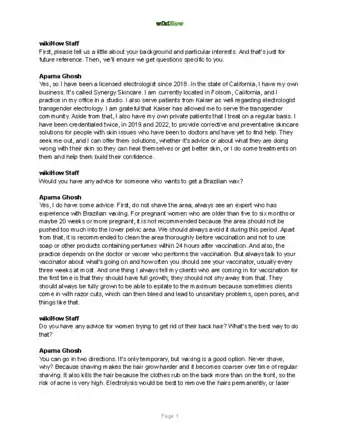
Thanks for reading our article! If you'd like to learn more about using body butters, check out our in-depth interview with Aparna Ghosh.
References
- ↑ http://www.naturallivingideas.com/diy-body-butters/
- ↑ http://www.naturallivingideas.com/diy-body-butters/
- ↑ https://www.self.com/story/the-best-time-to-moisturize
- ↑ https://www.self.com/story/the-best-time-to-moisturize
- ↑ https://www.leaf.tv/articles/how-to-use-body-butter/
- ↑ https://www.leaf.tv/articles/how-to-use-body-butter/
- ↑ http://www.naturallivingideas.com/diy-body-butters/
- ↑ https://www.leaf.tv/articles/how-to-use-body-butter/
- ↑ https://www.herbalremediesadvice.org/calendula-body-butter-recipe.html
- ↑ https://www.leaf.tv/articles/how-to-use-body-butter/
- ↑ https://www.herbalremediesadvice.org/calendula-body-butter-recipe.html
- ↑ http://www.naturallivingideas.com/diy-body-butters/
- ↑ http://www.naturallivingideas.com/diy-body-butters/
- ↑ https://www.self.com/story/the-best-time-to-moisturize
- ↑ https://www.leaf.tv/articles/how-to-use-body-butter/
- ↑ https://www.self.com/story/the-best-time-to-moisturize
- ↑ http://www.naturallivingideas.com/diy-body-butters/
- ↑ https://www.leaf.tv/articles/how-to-use-body-butter/
- ↑ https://my.clevelandclinic.org/health/diseases/6173-contact-dermatitis
- ↑ http://www.naturallivingideas.com/diy-body-butters/
- ↑ http://www.naturallivingideas.com/diy-body-butters/
- ↑ http://www.naturallivingideas.com/diy-body-butters/
- ↑ http://www.naturallivingideas.com/diy-body-butters/
- ↑ http://www.naturallivingideas.com/diy-body-butters/
- ↑ https://www.herbalremediesadvice.org/calendula-body-butter-recipe.html
- ↑ https://www.self.com/story/the-best-time-to-moisturize
About This Article
To use body butter, apply it to your body right after you shower or before bed to help moisturize your skin. Just avoid using it on your face since it can clog pores and cause breakouts. After you rub the body butter into your skin, let it dry for a few minutes before putting on clothes. If you don't want to apply it to your whole body, try targeting spots that are particularly dry, like your hands, feet, and elbows. To learn how to moisturize your hands and feet overnight with body butter, scroll down!
